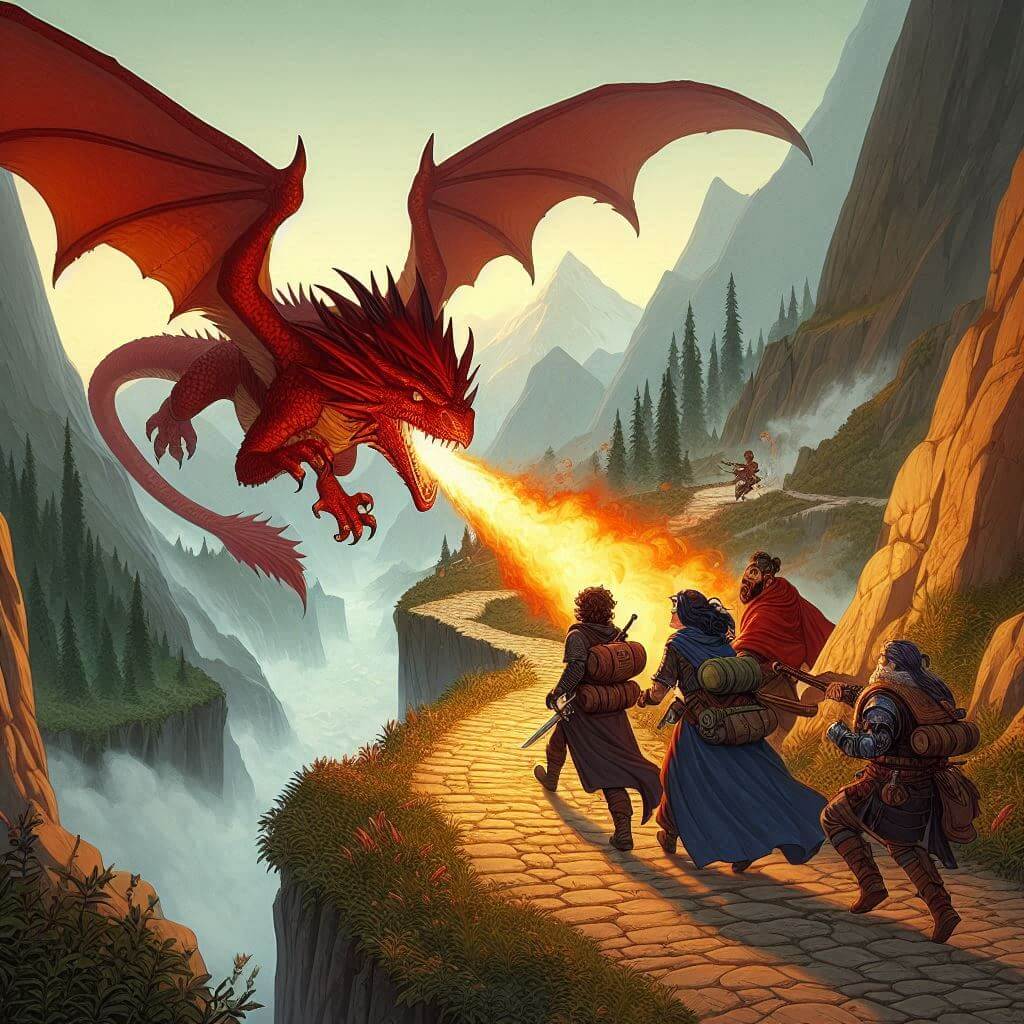Note: minions/allies have been provided because I always provide them, and I didn’t want to break my tradition. That said, if there is one monster that will not use minions, it will be the red dragon. It would scorn the very idea of needing help.
Combat rating 12
1 Young red dragon (CR 10)
3 Ogres (CR 2)
1 Orc war chief (CR 4)
Combat rating 14
1 Young red dragon (CR 10)
3 Githyanki warriors (CR 3)
1 Githyanki Knight (CR 8)
Combat rating 17
1 Young red dragon (CR 10)
1 Efreet (CR 11)
3 Salamanders (CR 5)
Combat rating 20
1 Young red dragon (CR 10)
1 Cambion (CR 5)
2 Barlgura (CR 5)
1 Galbrezu (CR 9)
3-4 Gladiators (CR 5)
How to Use: A Brute Force Approach
Combat Encounter: Part 1 (difficulty 11)
Red dragons belive that strength (meaning might) is all that’s important, and strategy is for weaklings. This makes creating fun encounters a bit challenging, possibly requiring either the use of homebrew, or convenient terrain.
(This also means that it is important that the players fight the dragon at levels 7-8, when it will be a challenge for them. No monster is a challenge at the level that matches its CR [D&D is built for 8 fights per long rest!], and it’s a shame to make fantasy’s biggest name and apex predator into a minor foe, easily defeated.)
I would try to place an encounter with a red dragon as taking place along a mountain passage, where the players are forced to travel no more than two abreast (side-by-side.) If it flies at them from around the side of the mountain they won’t see it right before it attacks, and will possibly even be caught completely unawares.
Option 1: The red dragon’s attack methods are, by definition, simple. It will hit them with a blaze of fire, catching as many of them as possible. If they split up, to avoid being all caught in the blast, it might be worth it for the dragon to land between them and so split them up. Otherwise, it will loop around the mountain and end its turn out of sight, then land among them the following turn. (Assuming its breath weapon doesn’t recharge. If it does, repeat this paragraph.)
Option 2: If you’re amendable to homebrew, I would have it charge right into them, landing upon one of them. The PC has to make a STR or DEX check (his choice) to avoid being knocked prone and having the dragon land on top of him, which should be the same as being grappled and possible also restrained. On the flip side, such rash tactics by the dragon should leave the players able to make an opportunity attack against it.
(There is some room to say that the following is just the normal result of landing on another character. I’m not really writing a homebrew ability for the dragon; I’m writing the logical outcome of a situation not covered in the rules.)
Option 3: A different way is to have the path crumble under the weight of the dragon landing on it. This will cause the dragon and one or more PCs to tumble down, and then the dragon can attack the PCs that fell with it while the other players work out how to get down safely. As a plus, having a hole in the path will split the players who are still on top into two groups.
Even more simple, have the dragon use the push attack action to knock a PC at the edge of the narrow path off it. The dragon can then either choose to follow that PC down, so that he can’t escape without taking an opportunity attack, or circle around out of range, and hopefully attack him next turn.
Part 2: Shifting the Attack
For the next part of the fight, the dragon will rely on its physical prowess to attack the players with basic attacks. Roleplaying is essential here, to make the dragon’s attacks feel like they’re coming fast and furious, and to downplay the players’ own attacks [within reason] as the dragon seems to shrug them off. If you can manage it, get the players to go fast with making their own attacks, as it will contribute to the fight’s tempo.
After 2-3 rounds, the dragon will most likely be losing (if it isn’t, I’m afraid the difficulty level was misjudged for your party), and it will be time to shake things up. Here are a few ways to do that:
The best way would be for the dragon to rise up and start battering at the cliffs about them, bringing down numbers of boulders to fall upon them.
If you prefer, you could have the dragon cause the cliff start to collapse, bringing down a wave of dirt and dust to hammer into the players, possibly burying some of them and pushing others off the cliff. If the players end up scattered, they’ll be easy picking for the dragon.
If you placed tents or a wagon in the area, have the dragon pick them up, dump them on the PCs to mess them up, and then set fire to them. They’ll be trapped inside a lethal fire.
If you put any type of herd animals around them, whether wild or raised, the dragon could drive them in front of itself as a stampede to flatten the players. Then attack itself.
With all of these, in order to roleplay it properly I would work to give the impression that the dragon is acting out of rage at their daring to fight back against it, not that it’s in trouble and needs this in order to save itself. I would say that the dragon isn’t capable of admitting that it’s in trouble.

Leave a Reply